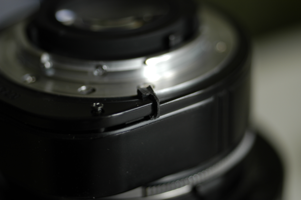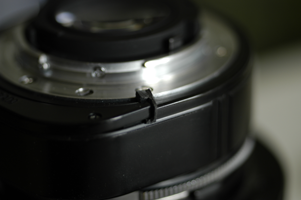MODIFY THE NIKON TC-16A TELECONVERTER.
By Oliver Perialis
I bought a TC-16A, even though I knew that it doesn’t work on my D100 or the D200 I was planning to get. But I thought I’ll take it anyway, since I don’t have any usable converter and this one is pretty cheap compared to the other ones. I figured I’ll try to find out why it doesn’t work, since I couldn’t even find any useful information on that.
Research
 |
First thing I noticed is the different pin layout on the TC-16A compared to all my other AF-lenses. I’ll call these pins 1 X 3 4 5 X 7 (as seen on the picture of the TC, where the X’s stand for empty spaces). |
 |
(above=TC-16A, here=Sigma 8mm) pins here: 1 X X 4 5 6 7 |
 |
So I openened the Converter to have a look where these pins connect to. There is a CPU inside, just like in any AF-lens. |
 |
This is the front of the circuit print. It features a NEC D7554G502 „CPU“ as its main component. Just for your information: the circuit print continues on the left all the way to the connectors: the top circuit path (top left pin of the IC) connects to pin 1 the next lower one (on left of the top resistor) to pin 3, then the next one down pin 4, then pin 5, and the very bottom circuit path (bottom right pin of the IC) connects to pin 7. |
 |
This is an IC I found which seems to be compatible. Turn it anticlockwise by 90 degrees to have it in the same orientation as on the picture above (front view). |
 |
On the back all the connections are visible.
|
| I didn’t want to open any of my AF lenses, to see where the difference was, but I didn’t need to after I found the results of someone having done exactly that (I could no longer find the source where I found this, so I cannot mention it here): [edit] Tazman (comment 75) found the source: A very interesting thread by „Ro Ro“ on photo.net [/edit] |
 |
And what do you know!? – its basically identical! Except for one difference, which is exactly what I was hoping for…
Pin 3 (on the TC) which was out of place anyway is connected to the IC in the same way that Pin 6 (on the AF lens) is connected!
Research result: JUST MOVE PIN 3 to the (unused) position 6… that’s it!!!
Method
A quick note to begin with: Most the feedback I get about this page is that the people tried this modification and lost one of the small golden springs. So please be careful with those – I don’t know where to get any spares!!
 |
This by the way is what the circuit print looks like at the other end. |
 |
So I drilled a hole (1.4mm for those who want to know, or just slightly wider – the metal contact that needs to fit through is exactly 1.4mm wide) in position 6, and made sure the metal contact fits well, and moves easily. I drilled it by hand, NOT with a Dremel or so, but just by rolling the drillbit between my thumb and index finger. It took a little longer, but gave me a much cleaner result. |
 |
Luckily Nikon didn’t save every milligram of plastic they could and there is already a notch in which the metal contact can slide, without touching the other contacts. |
 |
Now I soldered a little wire onto the little spring to electrically connect it to its old position on the circuit print. |
 |
Then put everything back together… |
 |
Oops, one more problem… The contact on the circuit print for Pin 5 is a little too wide and our new pin 6 would touch it as well, which is not good… |
 |
So I just covered that side of the contact with a little bit of cello-tape (I know this is not perfect, but the best Idea I could think of to make the whole process more or less reversible). |
 |
NOW put everything back together.. |
 |
|
 |
And finished!!! :-) |
D100 specifics
(probably more cameras, eg D70, D50, D80, F100, F80, etc)
 |
Just one more thing… |
 |
(I got an F E.E Error on my D100) |
 |
A little something (don’t know what it’s called) that moves a switch and this tells the D100 (and other cameras) that the aperture ring has been turned to minimum aperture (and so enables controlling all apertures via the camera). If you cut a piece of hard plastic (I used an old PC CPU fan) into the shape above, it fits really well (in a very good position) in between the Converter and the little cover for the „CPU compartment“. |
 |
Now we’re really done!! – That’s it! |
 |
This is how it looks on my 500mm f/8 Reflex Lens One more note: the Aperture the TC transmits to the Camera is always f1.0, as minimum and maximum aperture. So it is not possible to change the aperture at all. My 500mm (which I mainly bought this converter for) has a fixed aperture, so it’s not quite so bad, but it would be nice if this were different. |
D200 specifics
(probably applies to D1 and D2 series, D300 and D3 as well as F4, F5 F6)
Since the D200 has AI coupling, there is no physical switch like for the D100. Therefore, the little plastic thingy will not be necessary. However, somehow it didn’t work anyway (same F E.E error). The Trick is: go to CSM (Custom Setting Menu) under f: „Controls“, position f5: „Command Dials“. There, under „Aperture Settings“ choose „Aperture Ring“. This means you can’t control the Aperture via the subcommand dial anymore (so you’ll want to switch it back when you put a normal AF-D lens on the camera again).
Tools used
- Philips No.000 Screwdriver
- 1.4mm drillbit
- a very fine-tipped soldering iron
- a dremel (only for shaping the little plastic piece)
Parts used
- 1cm of very thin, insulated wire
- a small piece of hard (nonbrittle) plastic – got mine from an old PC CPU-fan
Limitations
OK, basically it works, but the use is very limited. It’s limited to the maximum aperture of the lens attached. On the D100 that’s it. Nothing you can do about it. On the D200 it only meters for maximum aperture, even if you set it to a different aperture. If you do want to use a different aperture, you’ll just have to dial in some exposure compensation.
Future Ideas
To overcome the aforementioned limitations, I believe the only solution would be to replace the chip with one that has a range of apertures, and not just „f1“ for both minimum and maximum aptertures (this is what imposes the limitations).
Notes:
I will not be held responsible for any problems caused directly or indirectly by following the above instructions/information. Use at your own risk!